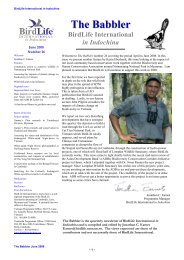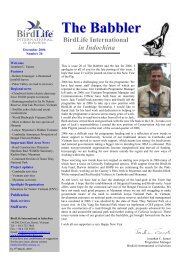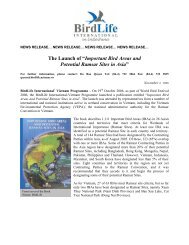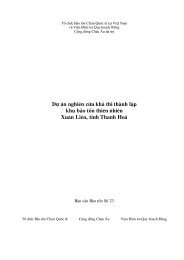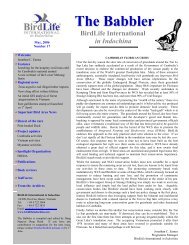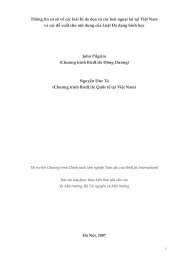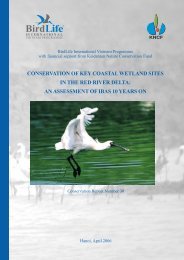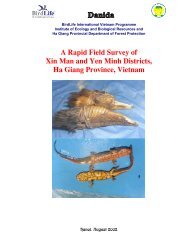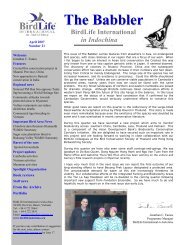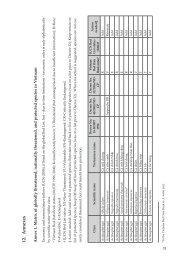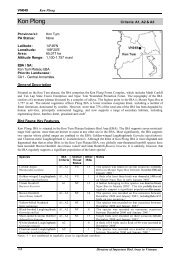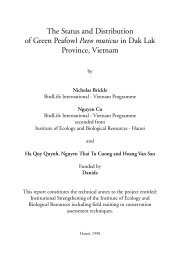The Biodiversity of Bac Huong Hoa Nature Reserve - Birdlife ...
The Biodiversity of Bac Huong Hoa Nature Reserve - Birdlife ...
The Biodiversity of Bac Huong Hoa Nature Reserve - Birdlife ...
Create successful ePaper yourself
Turn your PDF publications into a flip-book with our unique Google optimized e-Paper software.
monsoons, the nature reserve receives a considerable amount <strong>of</strong> rain. <strong>The</strong>re are rains in summer<br />
and autumn-winter; the dryer period lasts only 2-3 months. Most rain falls during August,<br />
September and October. <strong>The</strong> nature reserve also receives the “Phon”, a warm dry wind<br />
originating in Laos, during the months <strong>of</strong> March-June.<br />
Temperature<br />
<strong>The</strong> average annual temperature is 24-25 o C, however monthly temperature variation is<br />
considerable. December and January are the coolest months when temperatures drop to 20 and<br />
sometimes as low as 15 in areas above 500 m. In contrast, in June and July temperatures average<br />
29 and regularly reach 39 when the Phon is blowing.<br />
Sunshine<br />
<strong>The</strong>re are on average 4.5 hours <strong>of</strong> sunshine per day. July is the sunniest month, with an average<br />
<strong>of</strong> 6.7 hours per day, and February is the cloudiest, with an average <strong>of</strong> 2.3 hours <strong>of</strong> sunshine each<br />
day.<br />
Rainfall<br />
Annual rainfall totals for BHH NR are between 2400 and 2800 mm. <strong>The</strong>re are two main rainy<br />
seasons, the first lasts from August to November and accounts for nearly 50% <strong>of</strong> the annual<br />
rainfall. <strong>The</strong> second rainy season lasts from April to August and is characterised by less heavy<br />
rain. Between February and March there is light rain and December to January is the driest<br />
period.<br />
High levels <strong>of</strong> rainfall on unstable slopes lead to frequent landslides in BHH NR, particularly<br />
along the Ho Chi Minh Highway. Low lying areas also receive occasional partial flooding.<br />
Humidity<br />
In the context <strong>of</strong> humidity, there are two seasons. <strong>The</strong> humid season lasts from August to May,<br />
during these months the humidity is 85-90%. In June and July the Phon causes the humidity to<br />
decrease, sometimes to less than 30%.<br />
2.7 Threats to <strong>Bac</strong> <strong>Huong</strong> <strong>Hoa</strong> <strong>Nature</strong> <strong>Reserve</strong><br />
Although BHH NR has a small human population, the newly established protected area faces a<br />
number <strong>of</strong> threats. Some <strong>of</strong> the problems the reserve faces originate from the residents <strong>of</strong> the<br />
nature reserve, but the majority, and the most severe, are presented by people from outside <strong>of</strong> the<br />
nature reserve (Le Manh Hung et al. in prep.). <strong>The</strong> construction <strong>of</strong> the Ho Chi Minh Highway<br />
through the nature reserve has facilitated a rapid increase in negative pressures acting on BHH<br />
NR. <strong>The</strong> road enables illegally extracted forest products, including timber and wildlife, to be<br />
rapidly transported to towns such as Khe San.<br />
Hunting<br />
Hunting is probably the most significant threat to the biological integrity <strong>of</strong> BHH NR.<br />
Circumstantial evidence indicates that hunting has intensified in recent years, probably following<br />
the construction <strong>of</strong> the Ho Chi Minh Highway but also as part <strong>of</strong> a nationwide trend which has<br />
seen the wildlife trade network become increasingly commercial. Local residents have always<br />
16




